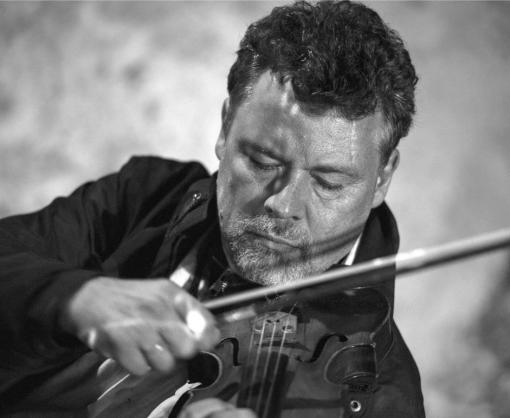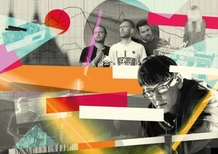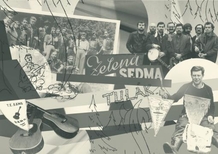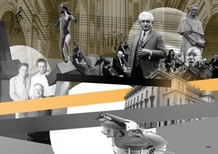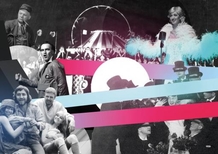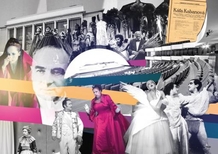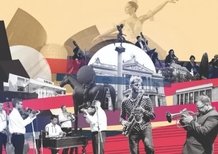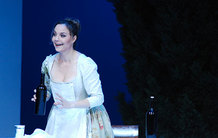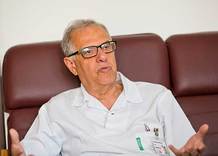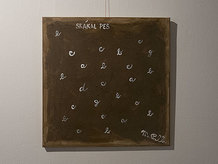Boris Klepal
News
Feature articles
We met violinist Pavel Fischer at the Budějovická metro station in Prague, and on the way to the Dobeška Theater we managed to discuss his holiday in Italy. At the time, we were already working out the subtitle of this year's Concentus Moraviae festival “From Roots to the Future”. Next to Dobeška, where the Sklep Theater plays, is what we call the “woodshed”, where the Škampa Quartet has been rehearsing for thirty-five years. Pavel Fischer was a founding member of the ensemble which he left at a time when it was enjoying one international success after another. As he says, he was attracted by greater musical freedom and a quieter life. At Dobeška, after our interview, he had a concert with cellist Olin Nejezchleba and guitarist Norbi Kovács. We started with him, although our main topic was Fischer's residency at this year's Concentus Moraviae. more
Electronic music, big beat and clubbing go together - but that’s only a small part of the truth. In fact electronic music was here long before clubbing, and thanks to enlightened teachers at JAMU it was doing very well indeed in Brno as early as the 1960s. That is, long before synthesizers and sequencers appeared on rock podiums, long before any old band had a computer, long before the first dance parties in glittering halls and dark cellars. Today electronic music is one of music’s most omnipresent genres: neither dance parties nor contemporary operas can do without it. Electronic big beat music has occupied reggae and swing, remixing is a daily affair, Brno artists have learned to sell instruments they built themselves to the whole world and to amplify an old knitting machine. As early as 1907 the composer Ferruccio Busoni dreamt of the future potential of electronic music, but not even his imagination and genius could have anticipated what Thaddeus Cahill’s first weird experiment with an immense electrical organ would lead to one day. more
”It’s a long journey to the West, / Pointless, fruitless is the longing,” began the first cowboy song recording issued by R. A. Dvorský’s publishing house in 1939. The theme and tone reflect the “tramping” movement, with its idealized vision of “America” and its unspoiled “nature”, which led Czechs to take to the woods, where they hiked, met round campfires and sang songs modelled on American folk songs and country music. So widespread was the tramping phenomenon that it made its way into popular music, where it long remained. Over time, the romance of the cowboy and the idea of a free life on the Great Plains found their way not only into songs sung by such late twenti- eth-century stars as Karel Gott, Helena Vondráčková and Waldemar Matuška but into social life itself: very few countries in Europe have such liberal laws when it comes to sleeping overnight, or even setting up camp, in the woods. In the past young people in Brno could choose whether to be “city slickers” hooked on discotheques or “wander- ers”, who would head for the main train station every Friday afternoon or Saturday and from there set out on the first train for wherever in the countryside it was heading to. more
Cultivated music, art music, serious music … shifting from one of these messy labels to another usually has one aim: to avoid the problematic “classical music”. Today this misleading term covers everything that was heard in medieval churches, in the course of Baroque festivities, in the age of bourgeois revolutions and at experimental concerts that saw shoes being thrown at the performers. Brno happily recalls visits here by Wolfgang Amadeus Mozart, Franz Liszt and Bedřich Smetana, short as they were. But it also remembers the Hollywood film music celebrity Erich Wolfgang Korngold, who spent his earliest years in Brno. Brno might appear to be a city of brief sojourns, were it not for Leoš Janáček, who made it his home and in the course of the past forty years has become one of the world’s most frequently performed composers. But the musical history of the city mirrored the turbulent political changes in the nineteenth century and drew on the enormous energy released by the creation of a free Czechoslovakia in 1918: never since then has its progressive character vanished completely. more
Operetta is a wilful child that stopped obeying its parents and ran away from the opera house. Its origin is much more explicable when one considers France, where operetta emerged in the midnineteenth century as an entertaining and often very sarcastic polar opposite to the megalomaniacal productions of “grand opera”. In Brno, as was the case everywhere else in the world, operetta appealed to the broad public, offering both social satire as well as quite conventional entertainment. In the interwar period, thanks to the enlightened lead of Oldřich Nový, it took on a sophisticated polish. Later the Brno theatre scholar Ivo Osolsobě was able to give it a solid theoretical basis, and so move on from the stultified operetta to the lively musical. Today Brno boasts not only a theatre built specifically for musicals but a degree programme in Musical Acting at JAMU. Through the musical A Ballad for a Bandit the brigand Nikola Šuhaj set off from Brno into the world of theatre and film, while Brno’s Liza Doolittle made her living as My Fair Lady of Zelný trh, Brno’s ancient market square. And so we’ve come full circle: the square is the site of the Reduta theatre, operetta’s home in times past. more
“Every theatre is a madhouse, but opera is the ward for the incurable,” claimed Franz von Dingelstedt, the first director of the Court Opera House in Vienna. And he was right, for once someone’s fallen in love with opera, that’s it. Opera’s a stepchild of the Renaissance, with a Baroque wet nurse: it was on the cusp between these two great eras that the idea of purely sung theatre saw the light of day. Step by step, composers taught the art of singing to classical gods and brave women, Christian heroes and pagan enchantresses, a Seville barber, a Babylonian king and the Czech Mařenka and Jeník. But it was only here in Brno, thanks to Leoš Janáček, that truly psychological musical drama was born, drama that sees into a person’s heart. Today the Brno opera company has its home in a theatre named after Janáček, mounts a major festival devoted to the city’s most famous composer every two years, and has set its sights very high. “The more opera is dead, the more it flourishes,” pronounced the philosopher Slavoj Žižek when speaking of this fanatically loved but just as fanatically rejected genre. By this measure, opera in Brno these days must have been dead at least a dozen times. more
To write a guide to music in Brno in the past and present means digging deep into one’s own recollections and those of others as well as into sources with varying degrees of reliability, and as far as possible not believing anything automatically but always asking “Did this really happen just like that?” And in doing so, to be very, very suspicious of one’s own memory. Two basic questions that cropped up in connection with almost every sentence were “What is it about this band or that event that makes them special? Would someone who’s never been to Brno and has no ties with the city find it interesting?” more
Last year, soprano Martina Janková, baritone Tomáš Král and pianist Ivo Kahánek recorded an album of folk songs edited by Leoš Janáček. Visitors of the 2016 Janáček Brno Festival will also have the opportunity to experience its live performance. The only change is that Roman Hoza will perform instead of Tomáš Král at the concert in the Villa Tugendhat. Martina Janková talked about her journey from childhood with folk music to Janáček. more
How does the Mozart effect work? Why does Mozart's music reduce epileptic discharges in the brain, while Haydn's does not? How do the brains of the audience without musical training and professional musicians perceive music? We were looking for answers with the head of the Centre for Neuroscience of the Central European Institute of Technology (CEITEC), Professor Ivan Rektor. more
The Partitury ze života (Scores of Life) Exhibition is the second of the four-part series that maps the musical concept of artists tied to Brno. Jan Steklík, Jan Zuziak, Miloslav "Sonny" Halas and Marian Palla exhibit in the Místogalerie on Skleněná louka. more




